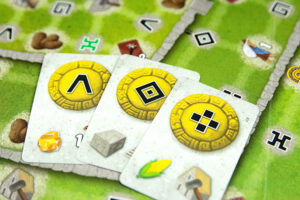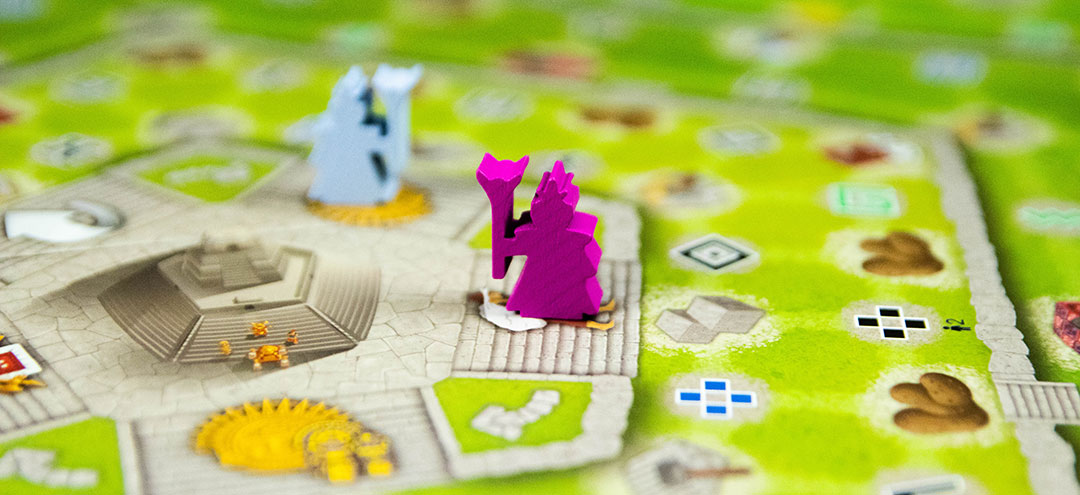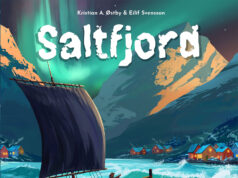 Another day, another heavy euro game starting with T from Boards & Dice. Designed by Dávid Turczi, this one has players taking the role of high priests expanding the Incan empire around Coricancha temple in the center of the board.
Another day, another heavy euro game starting with T from Boards & Dice. Designed by Dávid Turczi, this one has players taking the role of high priests expanding the Incan empire around Coricancha temple in the center of the board.
There is no shortage of complicated euro games to spend an evening with. Let’s explore how Tawantinsuyu works and talk about if it’s worthy of its T-named title.
Gameplay Overview:
When you fold out the board for Tawantinsuyu, be prepared for a deluge of symbols on what is perhaps the busiest-looking board in recent memory. But don’t fear, the structure of the game is fairly simple. On your turn, you really have two choices: play a god card and place a worker on a space matching that god’s symbol or take two secondary actions.
If you place a worker, you get to take actions based on the icons around that symbol. However, the board is made up of three levels and five sections to each level. If you play a worker in the section immediately next to your high priest, there is no additional cost. However, if you travel around the temple or farther down from the center you will have to pay a food cost in corn or potatoes. Once placed, the surrounding actions will allow you to gather resources, construct buildings, weave tapestries, and other sorts of VP-providing options.

That doesn’t even start to get into the fact that different colored workers have different abilities. And when you place a worker you get additional icons based on how many like-colored workers are adjacent to it.
Alternatively, you can take a turn to perform any of the two secondary actions:
- Pray – draw two new god cards (from the face up offer for the top of the deck)
- Train – draw two army cards
- Recruit – take a new worker from the nomadic workers area
- Move high priest – move your priest one or two spaces clockwise around the Coricancha
If you move your high priest you’ll then also get to perform the action that they land on. These allow you to do things like play those army cards to conquer nearby regions, rejuvenate expended buildings or armies, or make offers of statues or corn to the gods in exchange for movement up the temple track (and more sweet VPs).
Regardless of the action you take you always have the ability to recruit a new worker at the end of your turn. You spend either corn or potato to take a worker from the village. If the village is empty that triggers the end of the round. An intermediate festival phase takes place where points are awarded for the temple track and conquest markers. After the third festival, additional end game scoring occurs and whoever has the most points wins.

Game Experience:
It’s your turn. You try to process your options. At the beginning of your turn you can only have two workers. You’ll start the game with 3 god cards and most often have a pretty small number of them (you have to pay food for any you are holding during festivals, so hoarding is discouraged). The number of things you can do still seems nearly infinite. Place a worker? Can you afford the cost to place them far away from your priest? Should you take secondary actions? How exactly do all these possibilities advance your likelihood to win anyway?!

Tawantinsuyu is very much a puzzly-type of euro. There are some long term plans you can make—focusing on a tapestry or the temple, for instance. But, any plans you do try to make can be easily disrupted by your opponents taking the worker placement spot you were hoping for. And you can’t just place anywhere you want to go, you have to have the matching god card. So it’s all about making do with what you have.
Generally, you’ll be looking for ways to add to your tapestries, advancing on the temple, or raising armies to make conquests. Those are where a lot of points lie. But you’ll need resources to do it. As the game starts to come closer to its end you may find a more directed objective like winning the majority in certain conquest regions. Maximizing your actions by placing like-colored workers together makes for interesting choices to have to make, especially when you may have to spend additional food to move away from your high priest to be able to do so.

The number of choices available can often lead to some slow turns as players may have to really math out what makes sense. While a little analysis paralysis can be expected in most heavy euros, I found it was too often the default while playing Tawantinsuyu. That brainpower often felt wasted at the end of the day as well as mostly I found myself overwhelmed with possibilities and just spinning the wheel in my brain and picking a path somewhat randomly.
These days I find my enjoyment of heavy euros is tied to how well the theme is integrated into the mechanisms. When the setting of the game makes sense with what you are trying to accomplish the game is easier to teach and more fun to experience. Tawantinsuyu’s theme isn’t necessarily pasted on—the idea of expanding the Incan empire and having to pay costs to travel farther makes perfect sense. But the rest of the options—conquering regions, creating tapestries, and making offerings to the gods—just feel too disconnected to really bring it all together. There are worse uses of theme in board gaming for sure, but I would have loved some more immersion.
Final Thoughts:
Tawantinsuyu is a really solid take on worker placement. There is some variability each turn on what you can do based on your god cards and available workers and a good mix of having some overall strategy and having to deal with those random elements. The food expense for placing your worker farther from your high priest (along with the ability to take a secondary action to move your high priest) gives another layer to consider on top of everything else.
All of those options do lead to games often wearing out their welcome and clocking in routinely over two and a half hours. The theme in Tawantinsuyu is unique but some of the scoring opportunities feel a little disconnected from what you are doing each turn.
Fina Score: 3.5 Stars – A solid, heavy worker placement game. The few unique elements are offset by it’s overall length and so-so use of the historically rich setting.
 Hits:
Hits:
• Good mix of strategy and tactics
• Food cost for venturing too far from your priest is a neat way to add costs to some placement spots.
Misses:
• Game can go on for far too long with AP-inducing turns.
• Theme integration is lacking
























Pretty garbage rating for a very stellar game. A “real solid take” is worth more than 3.5 stars. The Axomamma solo mode is phenomenal, which shockingly you make no mention of at all in your review. For that alone, I’d give my review of your review 1 star out of 5.
I also have to add this element of hypocrisy. Your very profile at the bottom of this review states, “Andrew enjoys games with lots of brain-burning decisions and unique themes. Heavy euros tend to dominate his game nights.” And you criticize the game for being “too AP-inducing”? Looks like you were bested here. Should modify that profile!
Wow. Well hello and thanks for your valuable feedback.
I didn’t review the solo game because I generally don’t play games solo. If you are looking for a review of the solo modes there are lots of places dedicated to that content.
As for your critique of the types of games I like… well, I don’t really care too much about your opinion. When playing with other players its important to realize how they an impact the enjoyment of a game. No one likes to sit around for 30 minutes before their turn comes up again. So if a game presents lots of options without much in terms of direction and how the options can be turned into points is hard to grasp, that can induce AP in a way that isn’t particularly fun.
It is great that you love it. I liked it. Maybe just be a bit less of a jerk.